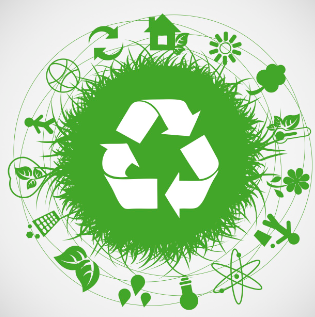The environment means the surrounding. The environment can be natural or artificial surroundings. The surroundings usually affect and are affected by human activities.
Taking people as the central point, any other thing that surrounds humankind is the environment. People directly or indirectly depend on natural surroundings for their live hood. Also by exploiting these resources, men get food, industrial raw materials, and medicine. In the efforts to satisfy human satiable needs, the natural environment has been destroyed or damaged, affecting human life.
A healthy planet is requiring to reduce poverty, attain equality in resource distribution, and feed the current generation without limiting the future generation’s capability of providing for its population. Other than the economic effects of environmental damage, there are may important aspects that effects of the world’s gradual ecological damage.
Environmental sustainability
Sustainable environmental management is the significant responsibility of states, firms, and individuals.
Sustainability is the process of utilizing limited natural resources efficiently and effectively without limiting the capability of upcoming generations to meet their own needs. Resources are not under equal distribution. However, they are enough for the entire world population only if they are well-managed and organized.
Despite this recognition of the need to protect the environment, forests, land, water, and fisheries are often over-exploiting by a few individuals who have influence and act in self-interest.
Clearly there is an excellent connection between environmental damage, industrialization and urbanization. According to the reports that human beings altered the natural environment and resulted in living in an unclean, polluted environment. On the other hand, the environment has limited the benefits that human beings could have derived from it.
Factors Affecting Sustainability

Industrialization
The world is fast industrializing, and urban centres are growing. Industrial processes and urban populations emit pollutants into the environment, decreasing environmental sanity. When wastes are not disposed of correctly, they adversely affect the environment. Industries produce greenhouses for the atmosphere, have solid wastes on the earth service and utilize raw materials from the environment. When this is the case, then the environment is damaged.
Population Rise
With the increasing world population, and the need to meet its current conditions, the world is over-exploiting the available natural resources to the point that some have become exhausted. The exhaustion means that future generations cannot meet their needs from such resources. Some people are not aware of the need to manage and conserve the environment, and they misuse the available resources and do not see it as their role to protect the environment.
Over-exploitation
Selfishness for individuals and firms has resulted in damage and over-exploitation of natural resources as people aim to meet their needs. Indeed the need to meet generational needs has relaxed some national and international rules where governments are not actively enforcing them.
Environmental Sustainability Trends
Transparency
Constructions, industries, and urban regions evaluate and disclose the use of energy, carbon discharge, and other environmental sustainability measurements. The landlords of commercial houses do not often have an opportunity. For example, five United States cities and three states have implemented policies which govern energy performance measurement and disclosure currently, and ten other states have proposed the implementation of these policies to support residents and investors in creating effective well-versed choices.
Transparency has grown in cities, and CDP requested 60 cities globally to account for environmental sustainability-associated information in 2011. Among them, 40 cities took action, with 35 taking responses from the public, which was the best idea.
CDP has increased its invitations to 150 cities worldwide. And they have experienced optimistic responses, along with unexpected knowledge and dedication on climate change matters by heads of cities. Clearly these city leaders identified that controlling water, energy, and waste would support the interests of the firms and tenants. Also it support to improve the standard of living in many approaches.
Global Consistency
Extensive reports for environmental sustainability by urban areas and multi-national corporations have strengthened. The reliable approaches to measure the efficiency of water, energy, and other environmental sustainability approaches from a global perspective.
Provided the broad local difference in environmental precedence all over the globe, the intended objective may not be a long international standard. But a method to interpret business activities and local government in international terms for measuring efficiency and identifying success.
LEED is the mechanism for ranking the housing environmental sustainability in the United States. It is often following in several countries with its mechanisms, as landlords aspire to magnetize global tenants.
In 2011, ISO 50001 standard was provided by International Organization for Standardization for energy. This organization structure contains conditions for measurement, certification, and accounting of energy usage.
Reliable measurements are vital to industries and companies. While they emphasize environmental sustainability in their personal functions and progressively all over their supply chain. As CDP cities are not putting any effort into rating the environmental sustainability of urban areas. Whereas they are building up an internationally cohesive background for recognizing the efficiency of environmental sustainability approaches followed by various industries and cities.
Public & Private Collaboration
Business organizations in the United States discovered their mutual goals in 2011. They recognized that association between private and public sectors and collaborative plans are frequently the efficient approach to overpower barriers to environmental sustainability. Some of these shared approaches would be felt mostly in 2012 and 2013.
The Better Buildings Challenge demonstrates the alliance between government and industries objectives in looking for carbon and energy decline and attaining these objectives as well needs support; for instance, organizations such as Greenprint Foundation and World Economic Forum have ordered reforms to loan supporting policies established by the legislative organizations to support funding of energy retrofits and more openly, states in America have realized that they can raise renewable energy installations at housing through providing inducements which would create solar power gainful for landlords within a moderately minimal time.
Jones Lang LaSalle, a section representing companies and government bodies, observes great unused synergy between companies and government bodies in attaining environmental objectives, especially in public and private associations.5 Taking one instance, airports and public bodies usually have surplus land, which is inappropriate for profit-making asset development such as the huge solar energy system.
Initiatives to attain the goal of environmental sustainability
Scientific innovations, inventions and development have resulted in better means of doing things to ensure minimal environmental pollution. The world is becoming a world village with improved transport and communication networks. The transport industry is the one that utilizes some of the world’s limited and exhaustible resources and fuel and then emits gasses that pollute the environment.
Collaborations among different countries have called for product improvement in such industries. Focus is currently on internal productions in a company where automation and recycling strategies embraced. To target different sectors and pollution, the international community is at the forefront of device mechanisms that will assist human beings in being sensitive to environmental damage. Such an initiative was the Kyoto Protocol on carbon emission.
Civil society, government and international bodies are targeting a transformation of human attitudes and perceptions towards the environment to ensure that people appreciate the need to conserve the environment for their and future generations’ good. The enlightenment from the massive campaigns is yielding fruits as people are becoming more sensitive about using the available resources.
The public is impacted by their attitude toward companies that do not have eco-friendly processes and products. A tendency is emerging that consumer power is forcing companies less concerned with the environment to revive their processes and products. Many companies have embraced corporate social responsibilities, which are targeting environmental conservation. These programs include tree planting, recycling and environmental education programs.
Conclusion
Humankind rely on the natural environment directly or indirectly for their live-hood. To ensure that the current generation meets its needs without limiting the degree to which future generation will meet theirs, Khaitan bio energy focus on effective conservation of the environment is necessary. Governments, international bodies, companies and individuals should join efforts to ensure minimal environmental damage.

